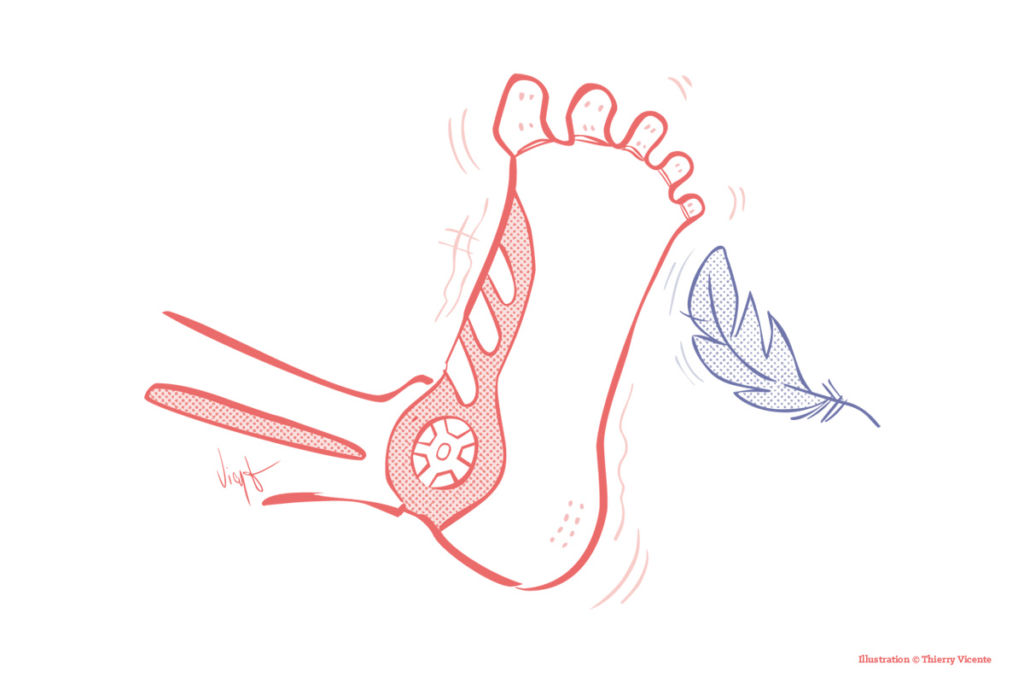[LUM#12] A giant step forward for prostheses
Is it possible to turn a prosthesis into a sensitive limb, capable of making its wearer feel contact with the environment? This is the crazy challenge taken up by a consortium of European researchers, whose results have been published in the journal Nature Medicine. At the heart of this innovation is the selective neural stimulation technology developed by Camin, a team from Montpellier.

Imagine a leg prosthesis capable of restoring the sensation of contact to its wearer. Rediscovering the warmth of sand in summer, the softness of damp earth or the roughness of a discarded carpet, even though the receptors generating these sensations have been removed with the amputated limb. It's sometimes only a short step from science fiction to reality, and science has just taken this step by successfully implanting the first sensory feedback neuroprostheses on a lower limb, after having already succeeded in doing so on the upper limb.
EPIONE is the name of this project led by a European consortium of Italian, Swiss, German and French researchers, each of whom has contributed the best of their expertise. "The Germans, for example, work on electrodes, while we specialize in selective neural stimulation. You have to see this prosthesis as a complete chain linking sensors to a stimulator, which in turn is linked to electrodes", explains David Andreu, researcher at the Montpellier Laboratory of Computer Science, Robotics and Microelectronics (Lirmm) and member of the Camin team.
A complete chain
At the base of this chain are the sensors installed on the prosthesis, whose role is to collect information on the external environment via their 36 points of contact. Is the ground harder, smoother or warmer? The information is then received by the stimulator implanted in the patient's body. This stimulator, designed by the Montpellier team, is the keystone in the operation of this revolutionary prosthesis. It must both translate the information from the sensors into electrical signals and use the latter to stimulate, via the four electrodes implanted in the nerve, the area corresponding to the desired sensation. "This is the heart of our know-how: our stimulator knows how to generate this by precisely stimulating a zone".
To fully understand the sensory feedback mechanism, we can compare the nerve to a large cable inside which we find a multitude of tiny wires: axons," continues David Andreu. Depending on which axons are stimulated, particular sensations are generated. This is what enables the patient to really integrate the prosthesis into his body schema."
Each electrode has 16 points of contact with the nerve, activating different sets of axons to send a whole range of sensations to the brain. The intensity with which the axons are stimulated then varies the intensity of the sensation felt.
A cartography unique to each
The problem is that the correspondence between axons and sensation varies from one individual to another, so it is necessary to configure the stimulator by mapping it with each patient after implantation. " For a given point, the patient has to characterize not only what he feels, but also the threshold at which he feels it, the maximum threshold at which he feels pain... The first trials took all day to explore the whole range of possibilities," explains David Guiraud, researcher at the FrenchNational Institute for Digital Science and Technology (INRIA) and head of this project in the Camin team.
This was a demanding experiment for the patients, whose sensations were tested for several hours a day over the six months of the trial. " As this was an experiment, the stimulator was external, so the electrodes were outside their bodies, which meant they had to stay in hospital to avoid any risk of infection," adds David Andreu.
Hands and feet
Although these first human trials in Serbia were a success, they required a great deal of involvement on the part of both patients and researchers. " We attended all the operations to test the electrodes and ensure that they had not been damaged by the surgeon during installation", recalls David Guiraud. " We then remotely monitored the evolution of the electrodes to adapt the stimulation."
The two researchers have now left the Camin team to launch their own spin-off called Neurinnov. And after sensory feedback on amputated limbs, the scientists decided to work on prehension to give tetraplegic patients back control of their hands. " It's the same thing, but in the other direction: we're no longer trying to create sensory feedback from a prosthesis, but to restore motricity to a real hand," explains David Andreu. It's a new challenge that the two scientists are set to take up... with flying colors!
UM podcasts are now available on your favorite platforms (Spotify, Deezer, Apple podcasts, Amazon Music...).